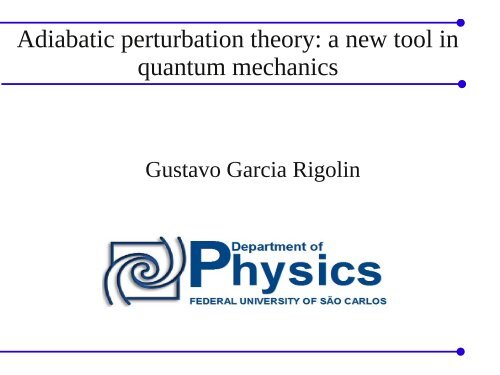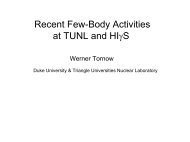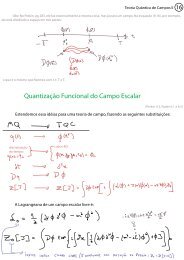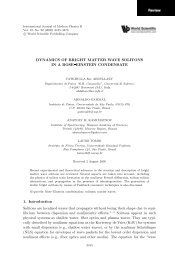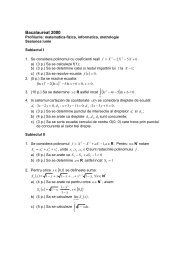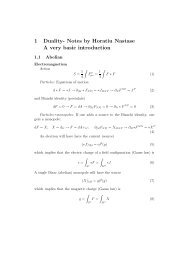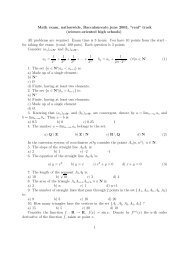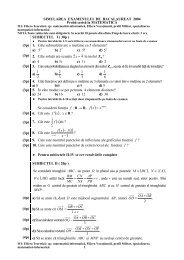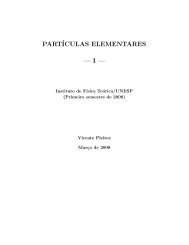Adiabatic perturbation theory: a new tool in quantum mechanics
Adiabatic perturbation theory: a new tool in quantum mechanics
Adiabatic perturbation theory: a new tool in quantum mechanics
Create successful ePaper yourself
Turn your PDF publications into a flip-book with our unique Google optimized e-Paper software.
<strong>Adiabatic</strong> <strong>perturbation</strong> <strong>theory</strong>: a <strong>new</strong> <strong>tool</strong> <strong>in</strong><br />
<strong>quantum</strong> <strong>mechanics</strong><br />
Gustavo Garcia Rigol<strong>in</strong>
Structure of the talk<br />
●<br />
●<br />
●<br />
●<br />
The adiabatic approximation (non degenerate);<br />
The adiabatic approximation (degenerate);<br />
Standard strategies to correct the adiabatic<br />
approximation (<strong>in</strong> a nutshell);<br />
The adiabatic <strong>perturbation</strong> <strong>theory</strong> (APT);<br />
– Exactly solvable model justify<strong>in</strong>g APT;<br />
– Numerical examples (<strong>in</strong> a nutshell);<br />
●<br />
The degenerate adiabatic <strong>perturbation</strong> <strong>theory</strong> (DAPT);<br />
– Exactly solvable model justify<strong>in</strong>g DAPT;<br />
●<br />
Corrections to Berry phase and Wilczek-Zee phases.
References<br />
Beyond the Quantum <strong>Adiabatic</strong> Approximation:<br />
<strong>Adiabatic</strong> Perturbation Theory<br />
G.R., Gerardo Ortiz, Victor Hugo Ponce<br />
Physical Review A 78, 052508 (2008);<br />
(Arxiv: 0807.1363v1 [quant-ph]).<br />
<strong>Adiabatic</strong> Perturbation Theory and Geometric Phases for<br />
Degenerate Systems<br />
G.R., Gerardo Ortiz<br />
Physical Review Letters 104, 170406 (2010);<br />
(Arxiv: 1001.5255v2 [quant-ph]).
The adiabatic approximation<br />
If a system's Hamiltonian H(t) slowly changes<br />
slowly changes with time,<br />
say, from t=0 to t = T, and the system starts <strong>in</strong> one of the<br />
eigenvectors of H(t), then dur<strong>in</strong>g the whole evolution it will<br />
stay <strong>in</strong> the correspond<strong>in</strong>g snapshot/<strong>in</strong>stantaneous<br />
eigenvector of H(t). In particular, for a cyclic evolution<br />
of H(t),
The adiabatic approximation
The adiabatic approximation for<br />
degenerate systems<br />
If a system's Hamiltonian H(t) slowly changes<br />
slowly changes with time,<br />
say, from t=0 to t = T, and the system starts <strong>in</strong> one of the<br />
eigenvectors of H(t), then dur<strong>in</strong>g the whole evolution it will<br />
stay <strong>in</strong> the correspond<strong>in</strong>g snapshot/<strong>in</strong>stantaneous<br />
eigenspace of H(t).
Formaliz<strong>in</strong>g the Adiab. Approx.:<br />
Rescaled Schröd<strong>in</strong>ger Equation<br />
where
The “ Berry ansatz”: no-degeneracies<br />
where<br />
snapshot<br />
eigenvector<br />
and
Geometric and dynamical phases
No degeneracies<br />
Eigen-energies<br />
Eigen-energies<br />
time<br />
time
Degeneracies<br />
Eigen-energies<br />
time
What are the b n<br />
(s) coefficients?<br />
Coupled Eqs.<br />
Comes from<br />
Schroed<strong>in</strong>ger Equation
The “strong” adiabaticity condition
Start<strong>in</strong>g at the ground state
Another way of express<strong>in</strong>g the strong<br />
adiabaticity condition
Usual ways of correct<strong>in</strong>g the adiabatic<br />
approximation: standard approach<br />
●<br />
1) We formally <strong>in</strong>tegrate the Schroed<strong>in</strong>ger Equation<br />
●<br />
●<br />
●<br />
●<br />
wich results <strong>in</strong>
Standard approach<br />
●<br />
2) We use the follow<strong>in</strong>g identity (cha<strong>in</strong> rule)
Standard approach<br />
● Which gives (up to first order)<br />
Time dependence at the r.h.s
Standard approach<br />
● 3) Solve it iteratively up to order 1:
The wave function to order one
The wave function to order one: start<strong>in</strong>g<br />
at the ground state |0(0)><br />
No term with n=0
Other methods<br />
●<br />
“Iterative rotat<strong>in</strong>g-basis method”
Problems with this method<br />
●<br />
●<br />
It is not a perturbative method <strong>in</strong> the the small<br />
parameter v=1/T.<br />
Only “asymptotically convergent”; After a few<br />
iterations the corrections get worse and worse.
Dyson series<br />
Good perturbative corrections if H(t) = H(0) + λV(t),<br />
with λ
Dyson series: drawbacks to correct the<br />
adiabatic approximation<br />
●<br />
●<br />
Not a perturbative expansion about the adiabatic<br />
approximation. Snapshot eigenstates not used as the<br />
basis for the perturbative correction;<br />
Not suitable as a <strong>perturbation</strong> series if H(t) cannot<br />
be put as H(0) + λV(t).<br />
Example:
Dyson series: drawbacks to correct the<br />
adiabatic approximation
Dyson series: drawbacks to correct the<br />
adiabatic approximation<br />
For w
<strong>Adiabatic</strong> <strong>perturbation</strong> <strong>theory</strong><br />
●<br />
Relevant properties:<br />
– “Easily” generalizable to degenerate Hamiltonians;<br />
– It has physical appeal; it is <strong>in</strong>tuitive; true perturbative<br />
expansion <strong>in</strong> v=1/T;<br />
– No differential equations; all correct<strong>in</strong>g terms come from<br />
algebraic recursive relations;<br />
– It is operational; can be applied to real problems; not<br />
only a mathematical “beauty” (or “beast”); it is<br />
numerically stable;<br />
– Transforms the time dependent Schröd<strong>in</strong>ger equation<br />
<strong>in</strong>to a set of eigenvalue/eigenvector problems.
Insights lead<strong>in</strong>g to APT<br />
● Come up with the right ansatz for ;<br />
●<br />
What sort of properties should the ansatz have?<br />
– It should make it explicit the dependence of<br />
with respect to terms of order<br />
and lower ;<br />
and lower
The Ansatz
The Ansatz
Initial conditions
<strong>Adiabatic</strong> approximation must be the<br />
zeroth order
Insert<strong>in</strong>g the ansatz <strong>in</strong>to the<br />
Schroed<strong>in</strong>ger Equation<br />
Problem for v → 0? No!
The recursive relations
The order 1 correction<br />
History (<strong>in</strong>tegration) of<br />
evolution is important
Order 1 correction start<strong>in</strong>g at |0(0)>
The wave function up to order 1
Sufficient conditions to the validity of<br />
the adiabatic approximation
The example justify<strong>in</strong>g the APT<br />
z<br />
B<br />
θ<br />
φ<br />
y<br />
x
The model's time dependent<br />
Hamiltonian
Snapshot eigenvectors and eigenvalues
Exact solution with <strong>in</strong>itial state |0(0)>
Expand<strong>in</strong>g the exact solution<br />
where
Expand<strong>in</strong>g the exact solution
Expand<strong>in</strong>g the exact solution
Corrections up to order 2 via APT
Corrections up to order 2 via APT
Corrections up to order 2 via APT
Corrections up to order 2 via APT
Corrections up to order 2 via APT<br />
Putt<strong>in</strong>g everyth<strong>in</strong>g together and compar<strong>in</strong>g with the expansions com<strong>in</strong>g<br />
from the exact result we realize that we get the same expressions!
Numerical examples<br />
●<br />
Three cases whose Hamiltonian looks like<br />
● All three cases we start at the ground state |0(0)>
Infidelity between the exact solution<br />
and what we get from APT<br />
Exact solution<br />
Normalized state com<strong>in</strong>g from APT
Numerical results<br />
t t²<br />
order 0<br />
order 1<br />
t³<br />
order 2
Numerical results: only order 2<br />
t¹<br />
t²<br />
t³
Degenerate adiabatic <strong>perturbation</strong><br />
<strong>theory</strong>: a bit of notation<br />
The “vector of vectors” notation:
The degenerate adiabatic approximation<br />
<strong>in</strong> this notation
The DAPT ansatz
The DAPT ansatz
Properties of the ansatz<br />
Initial conditions:<br />
Start<strong>in</strong>g at the ground state :
Schröd<strong>in</strong>ger equation <strong>in</strong> matrix form<br />
and the recursive relation<br />
Insert the ansatz <strong>in</strong>to SE and<br />
get recursive relations by left<br />
multiply<strong>in</strong>g to
What comes out of the recursive<br />
relations?<br />
●<br />
For p = 0 and n=m we get the Wilczek-Zee phase<br />
and the zeroth order as the adiabatic approximation
What comes out of the recursive<br />
relations?<br />
●<br />
For p = 0 and n m and p=1 with n=m we get the<br />
first order correction:
What comes out of the recursive<br />
relations?
Dirac matrices<br />
Exactly solvable problem
Pictorial view of the exactly solvable<br />
model<br />
Eigen-energy<br />
Time
Eigenvectors and eigenvalues
Exact solution start<strong>in</strong>g at |0 0 (0)>
Expansion of the exact solution up to<br />
first order<br />
Matches exactly what comes from DAPT.
Expansion of the exact solution up to<br />
first order<br />
Matches exactly what comes from DAPT!
Corrections to the Berry phase<br />
●<br />
Key concept: Aharonov-Anandan phase (state<br />
returns to itself)
Corrections to the Berry phase
Berry phase corrected up to order 1
How to measure the correction<br />
B 2<br />
is such that the upper<br />
beam acquires the proper<br />
dynamical phase<br />
B 1<br />
is rotated back and<br />
forth not too slowly
Corrections to the Wilczek-Zee phase<br />
S<strong>in</strong>ce we have the corrected state up to first order we can get<br />
the corrected WZ phase too. To first order we have,<br />
<strong>Adiabatic</strong> state<br />
What is actually seen
Corrections to the Wilczek-Zee phase<br />
To order zero we had,
Corrections to the Wilczek-Zee phase<br />
Keep<strong>in</strong>g terms up to first order,<br />
Giv<strong>in</strong>g the follow<strong>in</strong>g non-abelian phase,
F<strong>in</strong>al considerations<br />
●<br />
●<br />
We are look<strong>in</strong>g for <strong>quantum</strong> phenomena thought to<br />
be adiabatic, but whose experimental results do not<br />
agree with theoretical predictions rely<strong>in</strong>g solely on<br />
this assumption;<br />
We are look<strong>in</strong>g forward generalizations of APT to<br />
the degenerate case (done: DAPT); mixed states;<br />
open systems; relativistic <strong>quantum</strong> <strong>mechanics</strong>.


